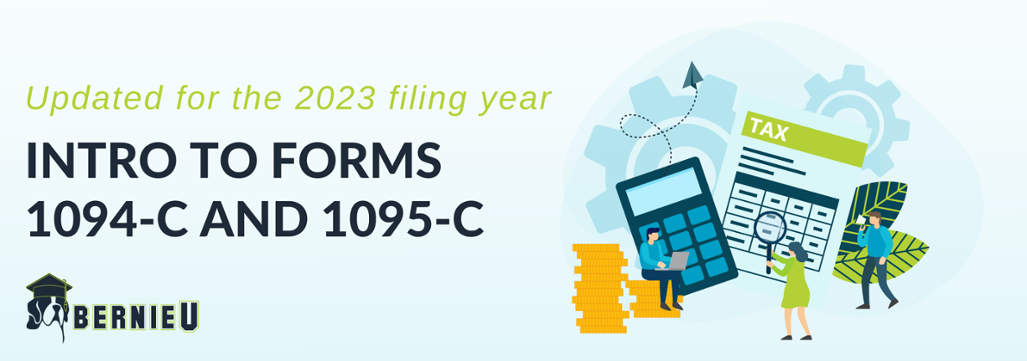
Written by
Drew Gieseke
Drew Gieseke is an aPHR®-certified marketing professional who writes about HR, compliance, and healthcare solutions.
IRS Releases New Draft of 2021 Form 1095-C for Filing in 2022

In July 2021, the Internal Revenue Service (IRS) issued an early release draft of Form 1095-C—an important ACA reporting document. While not ready for publication and use just yet, human resources departments should take note of a few updates to Form 1095-C—and prepare for potential changes to 1094-Cs. Read on to find out what HR needs to know.
Refresher: What Are Forms 1094-C and 1095-C?
The Affordable Care Act (ACA) requires employers with 50 or more full-time equivalent employees—also known as applicable large employers, or ALEs—to offer healthcare coverage to all eligible workers. The government tracks this information with Form 1095-C, which is filled out by all eligible employees (even if they don’t participate in the health plan). Failure to file these forms could result in a fine.
Likewise, Form 1094-C is used as a “cover sheet” of sorts for each organization’s collection of 1095-Cs and includes:
- The number of employees in an organization
- The number of 1095-C forms that are being filed
- A direct contact
- The employer, including contact information and the organization’s EIN
IRS Issues Draft Form 1095-C for Filing in 2022
In July 2021, the IRS released a draft Form 1095-C for filing in 2022, which applies for coverage held in 2021. While the drafts don't include any major changes, there are a few significant additions that have been incorporated. They include:
- Code 1T: This code applies when an individual coverage HRA (ICHRA) was offered to an employee and spouse without dependents. The affordability of the plan was determined using the Zip Code of the employee's primary residence.
- Code 1U: This code applies when an individual coverage HRA (ICHRA) was offered to an employee and spouse without dependents. The affordability of the plan was determined using the Zip Code of the employee's primary employment site.
Ultimately, employers should remember that these changes aren't yet permanent. In the draft, the IRS encourages employers to submit comments to the agency by using IRS.gov/FormsComments.
To learn more about ICHRAs, review the section below.
What is an ICHRA?
In 2020, the IRS issued final versions of Forms 1094-C and 1095-C with a few key updates to employer reporting. These changes included eight new codes—1L through 1S—that address a recently introduced type of HRA known as an individual coverage HRA (ICHRA).
Established by federal ruling in 2019, ICHRAs are account-based health plans that allow employers to better control healthcare costs by providing employees with defined, non-taxed reimbursements for qualified health insurance expenses. This can include monthly premiums for individual plans purchased through the Marketplace or through private insurance companies.
How ICHRAs Impact Form 1095-C Filing Moving Forward
The ACA requires employer-sponsored health coverage to meet an affordability threshold for the lowest-cost, individual-only plan. For example, in 2020, plan costs cannot exceed 9.83% of an employee’s household income. If an employer offers an ICHRA plan, they must use codes 1L through 1S to show how they determined the affordability of their coverage.
Codes 1L through 1S should be used under the following circumstances:
- 1L: If an ICHRA is offered to employees only and affordability is determined by a ZIP Code, which identifies an employee’s primary residence
- 1M: If an ICHRA is offered to employees and dependent(s) (not spouse) and affordability is determined by a ZIP Code, which identifies an employee’s primary residence
- 1N: If an ICHRA is offered to employees, spouses, and dependent(s) and affordability is determined by a ZIP Code, which identifies an employee’s primary residence
- 1O: If an ICHRA is offered to employees and affordability safe harbor is determined by the ZIP Code of the employment site
- 1P: If an ICHRA is offered to employees and dependent(s) (not spouse) and affordability safe harbor is determined by the ZIP Code of the employment site
- 1Q: If an ICHRA is offered to employees, spouses, and dependent(s) (not spouse) and affordability safe harbor is determined by the ZIP Code of the employment site
- 1R: If an ICHRA is not affordable and is offered to employees; employees and spouses or dependent(s); or employees, spouses, and dependent(s)
- 1S: If an ICHRA was offered to a worker who isn’t a full-time employee
Other Recent Form 1095-C Changes to Filing Instructions
In 2020, the IRS introduced a handful of other changes to ACA reporting forms. These included:
- Plan Start Month: All Applicable Large Employers (ALEs) must enter a two-digit code on 2020 Form 1095-C.
- Age and ZIP Code Inclusion: If an employee was offered an ICHRA, employers must enter the employee’s age as of Jan. 1, 2020. Similarly, the employer must submit the ZIP Code of either the employee’s permanent residence (codes 1L, 1M, or 1N) or the primary site of employment if the ALE Member uses the work location safe harbor (codes 1O, 1P, or 1Q). The ZIP Code is included on Line 17 of the form if the employer used it to determine the affordability of an ICHRA.
- Relief for Failure to Furnish: The IRS won't impose a penalty on employers that fail to furnish Form 1095-C to any employee enrolled in an ALE's self-insured health plan. This applies to employees who weren’t full-time workers for any month in 2020 (assuming certain conditions are met).
- Extension of Good Faith Relief for Reporting and Furnishing: The IRS won't impose penalties for reporting incorrect or incomplete information on Form 1095-C if a good-faith effort is made to comply with reporting requirements. In this instance, “good faith” means that employers didn’t purposely misinterpret or misreport information.
What About Form 1095-C Reporting Deadlines?
The IRS has yet to release reporting deadlines for filing in 2022. With that said, this blog will be updated once these dates are available.
In the meantime, employers should reevaluate their approach to filing before the new year. An all-in-one HRIS like BerniePortal can streamline the process, saving time, money, and headaches. Review the software's features here or request a demo to learn more.

Written by
Drew Gieseke
Drew Gieseke is an aPHR®-certified marketing professional who writes about HR, compliance, and healthcare solutions.
Related Posts
We just wrapped up another phenomenal Weekdays with Bernie (WWB) Conference!
Employees are the heart and soul of an organization, and valuing their opinions can have...
HR parties of one already have an abundance of tasks to keep up with. From hiring to...
The talent search is no longer a skirmish or a battle. It’s a WAR! As a strategic HR...







Submit a Comment